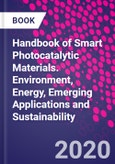Handbook of Smart Photocatalytic Materials: Environment, Energy, Emerging Applications and Sustainability provides an intriguing and useful guide to catalysis and materials. The handbook covers applications of smart photocatalytic materials for energy environmental protection and emerging fields. Also covered is the safety risk of Smart Photocatalytic Materials, commercialization, their fate and transportation in the environment, and sustainability. This volume provides a valuable roadmap, outlining common principles behind their use. Every chapter of this volume presents state-of-the-art knowledge on sustainable practices of smart photocatalytic materials (SPMs), including concepts of theory and practice.
This handbook is a valued reference for both the academic and industrial researchers looking for recent developments in the field.
Please Note: This is an On Demand product, delivery may take up to 11 working days after payment has been received.
Table of Contents
Section I: Photocatalytic materials for Energy 1. Ferroelectric semiconductors for photocatalytic energy and environmental applications
Section II: Photocatalytic materials for environmental protection
2. Metal-oxide semiconductor photocatalysts for the degradation of organic contaminants 3. Different strategies of surface modification to improve the photocatalysis properties: pollutant adsorption, visible activation, and catalyst recovery 4. Sustainable photocatalytic porcelain gr�s slabs active under LED light for indoor depollution and bacteria reduction
5. Zinc oxide-based nanomaterials for environmental applications
6. The application of photocatalytic materials for efficient� air purification 7. Photocatalyst: mechanism, challenges, and strategy for organic contaminant degradation 8. Degradation of environmental contaminants by� topical heterogeneous photocatalysts 9. Solar photocatalysis for environmental remediation 10. Progress in the preparation of TiO2 films at boron-doped diamond toward environmenta applications
Section III: Emerging Applications of Photocatalytic materials 11. Emerging trends in photocatalytic transformation of biomass-derived glycerol into hydrogen fuel and� value-added chemicals
12.Two-dimensional MXene-based heterostructures for photocatalysis
Authors
Chaudhery Mustansar Hussain Adjunct Professor and Lab Director, Department of Chemistry and EVSC, New Jersey Institute of Technology, Newark, NJ, USA. Chaudhery Mustansar Hussain is Adjunct Professor and director of laboratories in the Department of Chemistry andEnvironmental Science at New Jersey Institute of Technology (NJIT), Newark, New Jersey, United States. His research is
focused on the application of nanotechnology and advanced materials, environmental management, analytical chemistry,
smart materials, and technologies and other various industries. Dr. Hussain is the author of numerous papers in peerreviewed
journals as well as a prolific author and editor of around hundred (100) books, including scientific monographs
and handbooks in his research areas. He has published with Elsevier, American Chemical Society, Royal Society of
Chemistry, Springer, John Wiley & Sons, and CRC Press. Ajay Kumar Mishra Research Professor, Nanotechnology and Water Sustainability (NanoWS) Research Unit, College of Science, Engineering and Technology, University of South Africa, Johannesburg, South Africa. Prof. Ajay Kumar Mishra is a Research Professor in the Nanotechnology and Water Sustainability Research Unit at the University of South Africa. He obtained a B.Sc. in chemistry and a Ph.D. in bio-inorganic chemistry. His primary research interests are in nanoscience and nanotechnology, materials science, polymers, composites / nanocomposites, and water research. He is the editor of several books and published over 160 articles in international scientific journals. Prof Mishra currently awarded as Fellow and chartered scientist at a royal society of chemistry, UK








